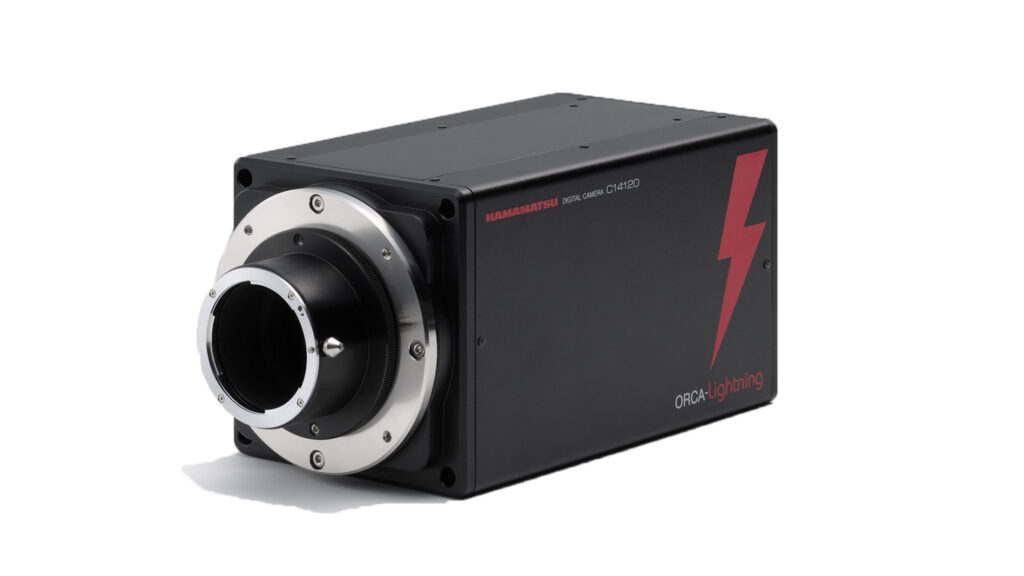
ORCA-Lightning Digital CMOS camera: C14120-20P
For imaging scientists, inspiration is often found at the edges—at the spatial, temporal, and optical boundaries of a system. It’s that grainy image of the cytoskeleton that has just enough photons to confidently resolve two unique molecules. It’s data extracted from a few pixels, whittled away from a larger array, to achieve capture rates relevant to neuronal signaling. It’s the mesmerizing cellular migrations of a developing embryo, reconstructed from a lightsheet time-lapse, that offer new insights and spark new questions.
By more than doubling speed, resolution and field of view relative to current scientific cameras, the ORCA-Lightning is designed to inspire new frontiers of exploration. Compared to a Gen II sCMOS, the ORCA-Lightning delivers 2 times the pixel area, 2.8 times the pixels and 3.4 times faster pixel-per-second readout.
All these increases translate to the ability to capture more image data faster, and still achieve Hamamatsu-quality images and information content. So whether you’re developing the next cutting-edge lightsheet system or building a library of the mouse connectome, the high throughput of the ORCA-Lightning will get you to your goal faster. And, we hope, open doors to new discoveries.
Features
- High resolution : 4608 x 2592 (12 Megapixels)
- High Speed: 121 frames/s (at full resolution)
- Read noise : 2.0 electrons rms (Standard Full Well Capacity mode)
- Pixel size : 5.5 μm X 5.5 μm
- Dynamic Range 17 000:1 (High Full Well Capacity mode)
- Peak QE : 60 % (at 550 nm)
High-speed imaging
Can even take high-speed images which were difficult to fully capture until now, with approximately 6 times the readout speed, while maintaining a level of readout noise similar to that of ORCA-Flash4.0 V3.
Speed comparison with ORCA-Flash4.0 V3
Cameras used in light-sheet microscopes put emphasis on high speed, demanding fast readout. Because images with increased readout speed result in obtaining fewer photons upon capture, it is necessary to keep the camera’s readout noise low when trying to capture high S/N images. ORCA-Lightning can capture images at approximately 6 times the readout speed, while maintaining a level of readout noise similar to that of ORCA-Flash4.0 V3.
Using CoaXPress as an interface and optimizing high speed data transfer to the PC, ORCA-Lightning realizes high-speed image acquisition.
Readout speed (for each effective number of pixels and modes)
Customers can select the best mode depending on their usage.
In addition to a readout from a Standard Full Well Capacity mode (12 bit), ORCA-Lightning also supports a readout from a High Full Well Capacity mode (16 bit) for high dynamic range.
| Effective number of pixels (H) × (V) | Readout speed (frames per second) | |||||||
|---|---|---|---|---|---|---|---|---|
| Free running mode *1 | Edge trigger mode *2 | Synchronous readout trigger mode *3 | Global reset trigger mode *4 | |||||
| 12 bit | 16 bit | 12 bit | 16 bit | 12 bit | 16 bit | 12 bit | 16 bit | |
| 4608 × 2592 | 121 | 30 | 121 | 30 | 121 | 30 | 120 | 30 |
| 2688 × 2592 | 208 | 30 | 207 | 30 | 208 | 30 | 207 | 30 |
| 2560 × 2560 | 221 | 30 | 220 | 30 | 221 | 30 | 220 | 30 |
| 2048 × 2048 | 307 | 38 | 305 | 38 | 308 | 38 | 305 | 38 |
| 1024 × 1024 | 610 | 76 | 603 | 75 | 612 | 76 | 600 | 75 |
| 512 × 512 | 1201 | 150 | 1175 | 146 | 1210 | 151 | 1166 | 145 |
| 256 × 256 | 2332 | 291 | 2234 | 279 | 2367 | 295 | 2203 | 275 |
| 128 × 4 | 31 725 | 3965 | 19 828 | 2478 | 39 657 | 4957 | 17 625 | 2203 |
*1 Free running mode is operated via camera alone.
*2 Edge trigger mode starts the exposure by the edge (rising/falling edge) of the trigger signal input to the external device.
*3 Synchronous readout trigger mode ends the exposure of the camera and readout is started, while the next exposure is simultaneously started by the edge (rising/falling edge) of the trigger signal input to the external device.
*4 Global reset trigger mode starts the exposure of all pixels all together by synchronizing the trigger signal from external device.
High speed test of 3D imaging
We took consecutive images and produced 3D imaging of a free-swimming Volvox.
When capturing the image of a free-swimming Volvox, imaging speed of 2-dimensional (area of observation) and 3-dimensional (number of images) settings were selected with a precondition of approximately 8 volumes per second.
With its high speed, ORCA-Lightning can capture clearer images within a wide range compared to ORCA-Flash4.0 V3.
Imaging conditions
- Microscope: ezDSLM (light-sheet microscope)
- Objective lens: 10×
- Excitation wavelength: 488 nm
- Fluorescence wavelength: red (autofluorescence)
- Sample: Volvox
- Observation target: Free-swimming Volvox
- Method of imaging: Acquisition of approximately 8 volume image (stereoscopic) per second
Collaborator: Laboratory for Spatiotemporal Regulations Exploratory Research Center on Life and Living Systems (ExCELLS) / National Institute for Basic Biology (NIBB), Dr.Atsushi Taniguchi, Dr.Shigenori Nonaka
Wide field of view
Comparison of sensor size between ORCA-Flash4.0 V3 and ORCA-Lightning
ORCA-Lightning covers the twice large field of view compared to ORCA-Flash4.0 V3, so that it can improve throughput and efficiency of work.
Sample image 1: Test pattern
Imaging condition
- Microscope: Nikon Ti2-E
- Objective lens: CFI Plan Apo Lambda 10× / 0.45
- F mount adapter: TI-BDTV2 +DS-F
- Sample: Plotting objective Micrometer (Calibrated in 0.01 mm girds, 2 mm Line length)
Sample image 2: Dendritic spines of neuron
Collaborator: Department of Cellular Neurobiology Graduate School of Medicine the University of Tokyo, Dr.Yutaro Kashiwagi, Dr.Shigeo Okabe
Imaging condition
- Microscope: Nikon Ti2-E
- Objective lens: CFI Plan Apo Lambda 100× oil / 1.45
- F mount adapter: TI-BDTV2 +DS-F
- Sample: GFP expressed mouse hippocampal neurons in dispersed cell culture (3 weeks culture)
- Pixel number: 4608(H) × 2592(V)
- Exposure time: 20 ms
Movie gallery
Collaborator: Laboratory for Spatiotemporal Regulations Exploratory Research Center on Life and Living Systems (ExCELLS) / National Institute for Basic Biology (NIBB), Dr. Atsushi Taniguchi, Dr. Shigenori Nonaka
Sample provider: National Institute for Basic Biology (NIBB), Spectrography and BioImaging Facility, Joe Sakamoto Ph. D (NBRP Medaka)
PC recommendation
With the introduction of the ORCA-Lightning, users are now able to stream 12 megapixel images to their computers 121 frames per second. The computer recommendations for this high data rate can be met by using the guidelines listed this PC Recommendations for ORCA-Lightning.
Specifications
| Type number | C14120-20P |
|---|---|
| Quantum efficency | Over 60 % (at 550 nm) |
| Imaging device | Scientific CMOS image sensor |
| Effective no. of pixels | 4608 (H) × 2592 (V) |
| Cell size | 5.5 μm (H) × 5.5 μm (V) |
| Effective area | 25.344 mm (H) × 14.256 mm (V) |
| Full well capacity | Standard Full Well Capacity mode: 1000 electrons High Full Well Capacity mode: 38 000 electrons |
| Readout speed | 121 frames/s (at full resolution) |
| Readout noise | Standard Full Well Capacity mode:1.5 electrons median Standard Full Well Capacity mode:2.0 electrons rms High Full Well Capacity mode:2.2 electrons median High Full Well Capacity mode: 2.7 electrons rms |
| Exposure time | Standard Full Well Capacity mode: 6.304 μs to 1 s High Full Well Capacity mode: 50.432 μs to 1 s |
| Cooling temperature | Forced-air cooled (Ambient temperature: +25 ˚C): +20 ˚C Water cooled: +20 ˚C |
| Dark current | 15 electrons/pixel/s (Typ.) : Air cooled (cooling temperature: +20 ˚C) |
| Dynamic range | Standard Full Well Capacity mode: 650 : 1 High Full Well Capacity mode: 17 000 : 1 |
| Sub-array | Yes |
| Binning | 2×2, 4×4 |
| External trigger input | Edge trigger, Global reset edge trigger, Level trigger, Global reset level trigger, Synchronous readout trigger, Start trigger |
| External trigger signal routing | SMA |
| Trigger delay function | 0 s to 10 s in 1 μs steps |
| Interface | CoaXPress (Quad CXP-6) |
| A/D converter | Standard Full Well Capacity mode: 12 bit High Full Well Capacity mode: 16 bit |
| Power consumption | Approx. 200 VA |
| Ambient operating temperature | 0 ˚C to +40 ˚C : Forced-air cooled (With no condensation) |
| Ambient operating humidity | 30 % to 80 % |
Spectral response
Dimensions
Downloads
Newsletter
Be the first to get all the information about new products in our range and find out the latest research results in microscopy in our free newsletter.







